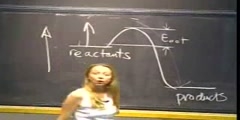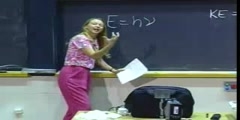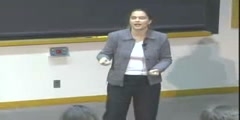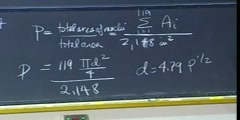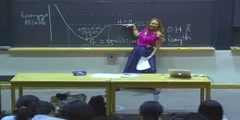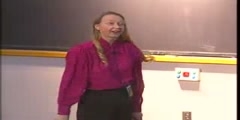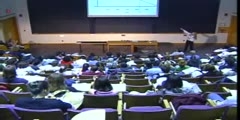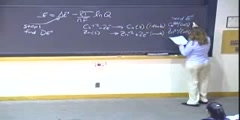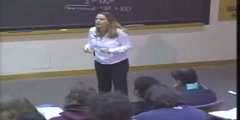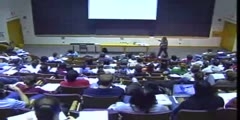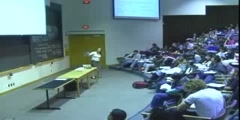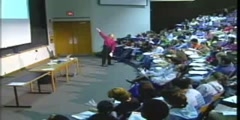Chemical Science -Transition Metals - Lecture 27
Principles of Chemical Science/n * Email this page/nVideo Lectures - Lecture 27/nTopics covered: /nTransition Metals/nInstructor: /nProf. Catherine Drennan/nTranscript - Lecture 27/nWe finished the unit on oxidation-reduction on Wednesday./nAnd so now we are moving into the next unit, which is transition metals, and that is Chapter 16 in your book. And following transition metals, the last unit is on kinetics or rates of reaction, and that is a little bit of a longer unit./nSo there are only two more units coming up in the course. Today I am going to introduce you to the transition metal unit, and this follows nicely from oxidation-reduction since you saw a lot of electrons being lost and gained./nAnd metals are definitely something that will gain and lose electrons, so it follows nicely from that./nToday is an introduction, and on Monday we are going to talk about crystal field theory, which is a topic that most people have not seen in high school. At least that has been true in past years./nIt looks a little bit scary sometimes to people because it looks different./nIt is not something that seems familiar. It is actually not that hard, but I strongly recommend coming and being present in lecture and working the problems. That is how you learn how to do this part./nAnd this often plays, this particular unit, on transition metals is a dominant theme on the final exam, so you will see it there./nIf people could settle down a little, I am even having trouble hearing myself./nThat is going to be Monday. And then on Wednesday we are going to talk about shapes of coordination complexes, and this fits in nicely with the transition metals. We are going to talk about vesper theory./nAnd then the following Monday we continue on and talk about how one can use crystal field theory to think about what colors molecules with transition metals have./nThese units, it is a little bit of a strange order this year because of the Thanksgiving holidays, but that is what is coming up./nAgain, this is a unit that most people have not seen before in high school. And, as I mentioned before, problem set nine, which is handed out today, you will see that it is really quite short. It just covers today's lecture and Monday's lecture./nIt just has a few problems on it, so it should just kind of keep you from falling behind with the material./nBut not take too much time so you will be able to get that done before Thanksgiving. All right./nToday there are a lot of topics. That is what happens when you introduce a new area. You need to go through a bunch of different kinds of definitions. And so today we are going to talk about coordination complexes./nAnd we are going to talk about coordination complex notation, coordination number, structures, just briefly of coordination complexes./nAgain, on Wednesday, we are going to be coming back next Wednesday and talking much more about these structures, but we will give a little introduction today./nWe are going to introduce something called the chelate effect and talk about isomers. And also, since we are talking about transition metals, we are going to start talking about d-electrons and d-orbitals./nThis is, again, all in Chapter 16 in your book./nHere is that relevant part of the periodic table that we will be talking about in this unit. These are what are called transition metals. And this is a part of the periodic table that is near and dear to the hearts of many faculty members in the Chemistry Department, including my own./nWe study proteins that use these metals to catalyze reactions./nAnd so this color scheme is actually out of a book that was published by Steve Lippard who is a faculty member in the Chemistry Department./nI will mention him again later in the day. He does a lot of work on the area called Metals in Biology, these transition metals that play a role in biological systems. And this book was also with Jeremy Berg who is the current head of the general medicine component of the National Institutes of Health./nAnd so he is somebody else who has thought a lot about metals in biology./nIn his case, in particular, zinc. Why are metals important in biological systems? Well, proteins, and I have talked some about proteins already, are composed of amino acids. You have carbon, nitrogen, oxygen, sulfur./nAnd there is quite a bit of chemistry that these particular elements can do, that amino acids can do, but there are some pretty challenging chemical reactions./nWe talked in the unit on chemical equilibrium about a challenging reaction, splitting nitrogen./nAnd I told you about the Haber-Bosch and how we need to do this to get fertilizers. And so it is an important industrial process that an enzyme can also do very efficiently without the high pressures and temperatures that human beings seem to need to get this reaction to go./nThat is one example of a protein that uses metals to do the chemistry./nAnd the active site of that enzyme is full of different kinds of metals. Up here says global cycling of nitrogen, hydrogen and carbon./nAnd so often some of the most fundamental reactions are also very challenging reactions and require metals to make them go. Radical chemistry reactions, making various products like vitamins or deoxy nucleotides, the building block of DNA./nAnd we have some DNA here with us today in class./nA lot of these reactions require metals. In this orange color here, those are metals that are found in biological systems, but there are also some metals in gray. And some have both orange and gray./nThere are other metals that are used as drugs or to probe biological systems./nThere is a whole area of sort of metals in medicine where people are using, say, looking at the use of gold for treating arthritis./nThere is a lot of relevance of these transition metals or d-block metals to medicine. Let's talk about the abilities of these metals to form complexes, and this is important for their ability to function in all systems, including the human body./nA key feature is that they can form complexes, and let's look at why./nAnd so these complexes then, of the metal and their ligands, are known as these coordination complexes. You have a positive metal ion, and it can attract electron density. And that is usually in the form of a lone pair of electrons from another atom./nAnd so when you bring together this metal and these other atoms and their lone pairs then you form this kind of complex./nAnd so if we look at the different roles that things play, you have a donor atom./nAnd they are called ligands. You often talk about a ligand being coordinated to a metal. And we mentioned Lewis acids and Lewis bases when we were talking about acid base, and we didn't really do much with them when we were talking about acid base./nAnd I said this would come back later./nLewis acids and Lewis bases are very relevant in terms of talking about how coordination complexes are formed. A Lewis base is going to donate lone pair electrons. And here are some examples. Again, these are referred to as ligands./nAnd so they would be acting as Lewis bases typically by donating their lone pair. Here are some of the ones that you are going to see in this unit./nAnd some of these will become familiar to you as we go through the next few lectures./nThey all have these lone pairs. And the metal is very happy to see ligands coming, and they will coordinate and form these coordination complexes. Then you need an acceptor atom, and that is the transition metal./nThat is going to act as the Lewis acid, and it is going to accept that lone pair that is being donated by the ligand./nLet's look at some example of some of these metals. And we saw some of these on the Periodic Table./nThese are all these d-block or transition metals. Then the coordination complex is the metal surrounded by the ligands or the Lewis acids surrounded by the Lewis bases. Here is a picture./nWe have cobalt in the center here, and then there are six NH3 groups which are acting as the ligands, and their lone pairs are pointing toward the metal./nAnd so, again, the coordination complex, all is meant by that is the metal surrounded by the ligands. And, in this case, there is a little bracket on the side with a plus three charge. And, for this particular complex, you might have like three chloride ions hanging around./nThree negative charged ions to kind of counterbalance the fact that this coordination complex has a plus three overall charge./nAnd so the charge would be distributed, but it is indicated that this whole complex has this charge by that little bracket and the plus three. Again here cobalt is acting as the Lewis acid. It is accepting the electrons that are being donated by the ligands./nIt is the acceptor atom./nAnd the NA3 groups are acting as the Lewis bases. They are the donor atoms, so they are donating a lone pair of electrons. Now we can introduce a term called coordination number, CN, and that is pretty simple./nIt is just a number of ligands that are bonded to the metal./nAnd so here there are six. The coordination number is six. That would be written as CN=6. And you have six ligands comprising the primary coordination sphere./nWe also have three chlorines hanging around, but they are not coordinated to the metal so they don't get counted in this. You are only interested in the ligands that are actually coordinated in the complex./nCN numbers typically range from 2 to 12, but 6 is the most common./nYou are going to be seeing a lot of different coordination complexes like this. Let me just show you how that would be written. When you are doing a problem in your book, it is mostly likely not going to be drawn./nYou are going to see notation for this instead. And so this particular one would be indicated, you have the cobalt and then you have your NH3 groups. There are six of them, so that is indicated there./nThen you have a bracket around the outside with a plus three, so that indicates that the charge of everything inside equals plus three./nYou also might see this where outside the bracket you have three chloride ions. And so you should be able to think backwards to this and say, well, if we have three things with a negative one charge./nAnd you see why the oxidation-reduction unit was important before this./nBecause we talked about oxidation numbers and all the rules for assigning oxidation numbers. You are going to need that knowledge to do this unit as well./nYou should know that this is going to be minus one for each chloride, so that would three, which would mean that if this is minus three, this bracket would be plus three, for this one down here is written to be neutral./nYou will be seeing this and need to back calculate./nThen you are also going to need to calculate what the oxidation numbers of the things within the bracket are as well. And we will talk more about that a little later in the lecture. Again, the NH3 within the brackets means it is bound to the cobalt./nThat would be this picture here. There are six of them so you would draw them as six around. And let me just mention a little bit about this particular configuration./nHere, where there is sort of a thick line coming out, indicates that it is coming toward you./nHere in this case you would have two atoms coming toward you. The dashed lines here are showing that there are two atoms back behind the plane. And then when you have the straight line, that is in the plane./nThis picture here is showing you this type of geometry, which is called what?/nOctahedral geometry, right./nLet's talk about octahedral geometry and the other geometries that you are going to see most often in this particular unit./nAgain, I am going to do much more on this on Wednesday, but this is just a very brief introduction to the structures that you will see the most in this particular unit./nFor a coordination number of six, you are just going to see one type of geometry, which is this octahedral geometry, which I just showed you./nFor coordination number of five, you will see two different types of geometry in this unit. And let's take a look at this. The first one over here, the trigonal bipyramidal./nHere is an example of that./nAnd I will try to have this as it is. Three ligands are in the plane. You have up and down and out here. One ligand is pointing out toward you with the thick line and another ligand is going back with the dashed line here./nThat is one there. We talked about the geometry./nAnd I forgot to mention that those are 90 degree angles, which I think is pretty easy to see when you look at it, that you would have 90 degrees in between those bonds./nAnd what about for this one? What do we have going for the red? What kind of angle is that? 120. And what about from the red to the black? 90. Those are the angles we would see and hear. And this is going to become important because we are going to be talking about d-orbitals./nAnd where the d-orbitals are for the metal, which is in the center of the coordination complex./nOne of the issues we will be discussing is where are the atoms with respect to those d-orbitals? Geometry becomes important at this point. The other type of coordination complex you might see, here the metal is gray in the middle, and so then we have our ligands bonded to it./nIf you have five ligands you also might see this geometry here, so this square pyramidal geometry./nAnd what are the angles between all of the atoms here? 90. Now, in the case where you have four ligands bound to your central metal there are two possibilities for the geometry that you will see./nOne is square planner. In this case, it is drawn with two ligands coming out towards you and two ligands going behind. And what would be the geometry between these guys?/n90 as well. And so this is one of the easy ones to remember because it is a square and it is planar./nThat is an easy one to remember. The other that you might see when you have four ligands is this guy tetrahedral. And what are the angles here? 109.5./nAnd then if you have three ligands, pretty much this is all you are going to see in this unit, and so we have the trigonal planar./nAgain, it looks trigonal and it is also quite planar. And what are our angles here? 120. And linear is going to give you what angle? 180. You will see this one as well./nAnd this model is a little old so it is not really so linear anymore but it is still supposed to be./nWe are going to bring back, I am going to bring these models to class for a lot of the next lectures because thinking about the structure is going to be very important in thinking about the properties of transition metals./nAll right. What else can transition metals do? What are some of the other things?/nWhen you talk about transition metals and coordination complexes, you need to talk about the chelate effect. We have seen so far ligands binding at one site, but some ligands can bind a metal at more than one site./nAnd so then you start talking about chelates. First a ligand that can bind a metal at one site is called unidentate or monodentate. And the dent comes from dentist or tooth./nThis would be one. If you have a ligand that can bind at more than one point of attachment then it is called a chelating ligand./nAnd the coordination complex that it forms is called a chelate. And so this is Greek for claws. It seems like claws are coming down and binding to the metal. Anything above one would be considered a chelate if it has two points of attachment or three or four./nBidendate means two points./nAnd this nomenclature, not too challenging. People are usually pretty good at guessing what they mean. Tridentate would have how many points of attachment? Three. Tetradentate? Four. Hexadendate? Six./nThere are some people, this was a question, I think, hexadentate on a final one year people got it wrong. Don't get something like that wrong./nSave the things you are going to get wrong for the really hard part./nThis is really not so difficult. That should be some bonus points there for you. If you remember the dentate, and this term actually gets used quite a bit, you will be all set. What is the chelate effect? Chelates are ligands that can bind at more than one point of attachment./nWhat is the chelate effect? Well, it turns out that metal chelates are very, very stable./nAnd so this is a thermodynamic property that they have. And it is believed, or the rationale for the stability which is observed, is that it is an entropic factor that is going on./nThe binding of that chelate at more than one point of attachment is entropically favorable because you are going to be releasing waters as you do this. We are going to come back, and I am going to explain this using an example in a few minutes./nFirst let me give you some examples of chelates and then I will show you how this chelate effect could work./nThere are examples of chelates in biological systems. And it may not be a surprise to some of you that one of the chelates is vitamin B12. And that would be one that I would pick to mention in particular./nHere the chelate, this is all one ligand. This whole bottom part is attached. It is one ligand./nWe have this called the corn ring. You have cobalt in the middle. And it is coordinated by this planar part./nAnd you have four nitrogen ligands coordinating. It is one ring system here called the corn ring that is attaching at four points of attachment. You also have an upper ligand here, and this is an adenosyl moiety./nAnd we have a lower ligand. And we talked about this before with buffers effects./nBecause, if this lower ligand is detached on the protein, it has to fit into a binding site. And genetic defects that block that impair the activity of the enzyme./nThat was mentioned before. This actually has six different ligands and will classify as a chelate or six different points of attachment and classifies as a chelate. Let me just sort of spin that around so you can kind of get a sense of the geometry here./nAgain, here is the cobalt in the middle, the upper ligand and the lower ligand./nAnd if we move that around, see if you can get a sense of the sort of geometry around that cobalt. You have four in a plane here, one on top and one on bottom, so it is sort of an octahedral type coordination of that metal in the center./nI thought I would just mention the person who determined the structure of vitamin B12./nThat is Dorothy Hodgkin. For her work on this, and on penicillin, she received a Nobel Prize, because at the time she was studying the structure it was really considered very large for the technique that she used, which is x-ray crystallography./nAnd people didn't think she would be able to determine where all those atoms were located in something that was that big using crystallography. Since then we have gone on to solve much larger structures./nBut she really opened the doors for people thinking about this technique as being important in biological systems./nShe had a number of graduate students who went on to do some pretty spectacular things and really helped to establish the field of crystallography. And I will just mention one of her graduate students who was not as successful as a crystallographer./nThis is what I do. And not everybody can do x-ray crystallography. It is a bit challenging./nAnd some people had to sort of find something else to do with their lives. One of her students didn't quite cut it as a crystallographer, but the good news is she was still able to find a job./nAnd it is actually kind of interesting that Dorothy Hodgkin was a real socialist. She was very involved in left-wing issues, but she stayed friend with Margaret Thatcher throughout the years. And it would have been very interesting to be in a living room with the two of them hearing them talk about politics./nMaybe they would talk about crystallography, I don't really know, if they were together./nThat might have been safer. That is one example of a chelate. Here is another example of a chelate, and this is called EDTA. And so it has many points for attachment to a metal. We have a lone pair up here on this atom, so we have a donor here./nWe have another lone pair, another donor site here. Another lone pair, another donor site here./nAlso over here and here and here. This ligand can attach to something in six places. Here, again, is the free molecule./nAnd here is what it looks like when it is attached to the metal. See this oxygen here, over here, and then if you follow it down over here this nitrogen is also coordinated. If we go over here then this oxygen is coordinated./nIf we come from this nitrogen over to the other nitrogen it is over here./nGo down to this oxygen, this oxygen is coordinated down here, and then in purple we have the last coordination. What is the geometry around that metal site? You have these six ligands, so what is that going to be?/nIt is going to be an octahedral./nYou should have angles around 90. And it is also hexadentate, so you have a ligand binding with six points of attachment. It would also have a CN number then of six. Why the chelate effect? Why are complexes like that so stable? The chelate effect could be viewed in this slide./nBefore you have the EDTA bound we have six water molecules around it./nThen we bind one molecule of EDTA. It binds in the hexadentate complex releasing all six waters. Where is entropy greater? When you have one free thing or when you have six free things? Six./nThis is entropically favorable. You are creating disorder./nYou are binding one thing and releasing six things. That is why these complexes are really quite stable. We are getting back to entropy now./nWe have been talking about delta G. We had delta H. Now we have delta S. That is the chelate effect. And we talk about it due to this entropic effect accompanied by the release of non-chelating ligands, usually water, from the coordination sphere./nIn this case, one ligand binding displacing six things is favorable./nThe chelate effect leads to a lot of practical uses. Here some of the uses would be in medicine. If you discover over Thanksgiving that you one and a half year old niece or nephew has discovered paint on the windowsill as peeling and is starting eating the paint off of the windowsill, you might want to remember when that was painted last and if there was lead in that paint and rush the child to the emergency room./nAnd when you get there, just in case the people there, you know, on Thanksgiving it is always dangerous to be in an emergency room./nYou might say give this kid EDTA. That is really what is used. And that will chelate then the lead out of the system before it can bind to things and do a lot of damage./nThis is one of the chelators that is used./nIt is a chelate effect. It works pretty well if someone has been exposed to something like lead, which is pretty toxic and you want to get it out of their system. That is one use. It is also in food./nIt is a food additive. Sometimes it is fun after you take a couple chemistry courses to actually start reading the labels of the food that you are consuming and some of those words will actually start making sense./nOne thing that you will often see is EDTA./nAnd it will say EDTA was added for freshness. One thing that EDTA can do. Microorganisms, bacteria, other things that you would rather not have consuming your food at the time that you also want to consume it need metals for life, as we all do./nIf you add EDTA, it is a good way of preventing other kinds of unwanted microorganisms from growing on the food./nBecause it will chelate all the metals and the organisms cannot live. Added for freshness is a more polite way of saying that this food is less likely to be contaminated with lots of bacteria growing on top of it./nAnother thing that it can be used for is bathtub cleaning or other kinds, but bathtubs and showers in particular. There is calcium in tub scum./nAnd most kinds of cleaners have something that chelates out that calcium which allows you to clean./nAgain, over Thanksgiving, one thing that happens to a lot of people when they go home is that their parents say help us clean to get ready for everyone coming. And so you might be using EDTA then as well./nI thought I would tell you a little story about how knowledge from freshman chemistry can make somebody money./nThis is a really kind of fun story. I don't know if it was around Thanksgiving, it might have been./nOne day Robert Black had a life altering experience. His wife said to him could you clean the tub? Apparently Robert Black had never cleaned the tub before that time, and so he went to clean it. Apparently, maybe it had not been cleaned in a while./nAnd he discovered that it is really hard./nYou have to scrub a lot to get the tub clean. He thought wouldn't it be nice if one never had to clean a tub? He came up with this idea. And here is one of the products that came out of this, Sparkling Shower, available at Leveret's./nAnd what he did was he put the same ingredients, including EDTA, in that you have in most cleaners, but he had sort of a novel pitch./nEvery time you take a shower, just squirt the shower or the tub, and then you never really have to clean it./nIn this patent he had a surfactant chelating agent, EDTA and an alcohol. You had a surfactant to sort of break up the water tension, the chelating agent to sequester out the salts in the scum and alcohol to dissolve the more oily ingredients./nAnd so those together kind of got everything loose and ready to go./nAnd the surfactant kind of helped it run off. If you squirt your shower every time you shower, you will never really have to clean it./nHe used all ingredients that were know before but packaged it slightly differently. Again, EDTA is one of the ingredients in these products. And so sales of these particular products have reached $70 million every year./nI think that the wife is probably very happy that one day she insisted that he clean the tub./nBecause this turned out to be a pretty profitable exercise. It is also an example of how some very simple chemistry can yield you quite a bit of money./nAll right. Tub cleaner. There was one more that I thought of. Anybody a fan of vampire movies?/nNot really all that many. It is a little surprising. I am not sure you are all telling the truth./nIf any of you happened to see Blade, you might be aware of another use for EDTA. If you remember, you may not have noticed what they were mentioning at the time, but they came up with a great way of killing vampires./nThere were these darts filled with EDTA./nI think the kind of general premise that you can rationalize this Hollywood special feature is that vampires drink blood, blood has iron, and if they are pretty much all blood, if you give them something that chelates out the iron it could cause some kind of harmful effect./nIn the movie they exploded and sort of disintegrated completely. If you take your niece or nephew to the emergency room for eating lead paint this will not happen./nI am quite sure. But it was really very spectacular./nHere they are, the little darts filled with EDTA. Again, more knowledge that could be useful on some occasion, perhaps, I am not really sure. I have a feeling that most of you will find the top three more useful, but here is the complete list that I have been able to come up with for the uses of chelators./nAll right./nThose are some coordination complexes, either single ligands bound around a central metal or chelating ligands bound around a central metal. There are other coordination complexes which have important features./nAnd one thing that we will talk about is isomers. Geometric isomers can have very different properties to them. It seems like it is pretty much almost the exact same compound./nBut the arrangement of the atoms is slightly different and that can yield two very different properties for those particular compounds./nLet's look at one example. This is platinum, and it has two NH3 ligands and two chloride ligands. And so that is in the bracket. Those four different ligands are coordinated centrally to the platinum./nIt would have a CN number of four./nAnd the most common shape that you would see for this would be this one here, this square planar shape. Depending on how you arrange the four different ligands two NH3 and two Cl, you get a very different result./nWe have, in this arrangement, a compound called cisplatinum./nYou have a cis arrangement where the chlorides are on one side and the ammonia groups are on the other side, or you can have transplatinum where the ligands are across from each other. Here are these two different molecules./nHere they are cis with respect to each other and here they are trans with respect to each other./nOne is a very potent drug that is used in treatment of cancer. The other has no known function. They are composed of identical atoms./nWhy is this different? Why are there different functions with the different geometries? Well, as it turns out, it is real important to have the atoms on the same side./nAs shown in this slide, I said I would mention Steve Lippard again, and here I am, this has been a subject of research in Steve Lippard's laboratory here in the Chemistry Department at MIT for a number of years./nIf you have a cancer cell and you want to kill the cancer cell, one thing that you can do is give it cisplantinum. The cisplatinum comes and binds to DNA. Here is a little cartoon of DNA here./nThere is the actual model of DNA structure down here in the front of the room./nWhen it binds then it can inhibit transcription. And so this can then lead to cell death. And so Steve has been really looking at this issue trying to redesign cisplatinum to see if you get a better drug, looking at other factors which might have an additive effect./nThis particular drug is used often for prostate cancer and has really been quite effective./nWhy does it matter if they are on the same side? Well, if you look at this complex and the other, you see that only two of these ligands are left./nTwo of the ligands are gone. At those sites it is actually coordinated to the DNA itself. That is why it is important that they are on the same side. You want to release two chlorides and have it bind to DNA this way./nIf it is on the other side, it really doesn't work as well. If we go over and look at the DNA molecule for a minute, you see that if you want to have two free sites to coordinate two DNA molecules./nOf course, this is the totally wrong scale./nYou want these on the same side. If I made it on the right scale it would not fit in the room, really. This is more or less, you can imagine. If you are going down here and you want to release just the chloride ligands, well, you cannot get the chloride ligands to be on the right side for this./nMolecules that have different shapes may have different properties./nAnd if you are in an environment you are looking to react with a particular molecule. I will show you another kind of view of DNA./nDNA is a really beautiful molecule. Here you have something you can carry around and show your friends, but also there is a smaller model of DNA. This is actually an artist in Michigan who will carve out within these blocks any atomic structure that you have./nAnd you can show the sort of bases in the detail./nThat is what DNA looks like sort of from the top and then from the side. It is just a really beautiful molecule. This is a nice example. Steve Lippard often takes a lot of UROP students, so it might be something, if you are interested in this area, that you might want to look at his Web page and see if that type of research interests you./nI lost my pointer./nThe cisplantinum has the effect because you need to release chlorides on the same side so that it can bind DNA over here. This cannot bind DNA because you don't have the chlorides together so they cannot be released and you won't interact with the DNA./nAgain, these different isomers have really, really different properties. Here we look at optical isomers or enantiomers./nAnd introduce the idea of a mirror plane here. When you have two different isomers, and if they are not superimposable, that means there is a mirror plane and that they are chiral./nAnd chiral molecules can have vastly different properties, again, if they are in a chiral environment such as the human body. Let's just look at these two./nSee that there is a mirror plane. Here we have the green on top, the NH3 on top, chloride in gray here on the bottom, and then on the side we have the oxygens, the black atoms here, more chlorides here, on the other side there are also oxygens pointing out in front, another NH3 group sort of putting in back./nAnd so they are very, very similar./nBut if you try to superimpose them, you will realize that it doesn't match up. If you try again other ways, put another green over here, no, that is wrong, too. And you can spend maybe not very long convincing yourself that, in fact, these are non-superimposable./nThey are mirror images so they are chiral compounds. And the idea of chiral compounds, we will come back, and you will hear much more about that if you take organic chemistry 5.12 or 5.13./nNow we have to get to some business that we need to think more about the properties of these elements./nAnd that is we need to count. A lot of counting in these units, oxidation-reduction, and also in this unit counting skills. We need to figure out how many d-electrons are involved in coordination complexes to be able to rationalize their properties./nThis is pretty straightforward./nOne can figure this out, what the d-electron count is if you know the group number from the periodic table and the oxidation number of the metal. We know how to calculate oxidation numbers at this point and the Periodic Table in your book./nLet's just take a look at a couple of examples and count some d-electrons. Suppose we have a coordination complex./nIt has cobalt in it, it has six ammonia ligands, and it has a charge of plus three for the overall complex./nThen we need to figure out what the oxidation number of cobalt is first. What is the overall charge on NH3? That is zero. This is a neutral molecule. And if you don't know that, this is something you will memorize as you go through this unit./nWhat does that leave you for cobalt? Plus three, because it all has to add up, just as it has before./nAnd so we figure out the oxidation number first. And then second we would figure out the d-count. We need to look at the Periodic Table and see where it is. Here we have cobalt in Group 9./nWe have Group #9 minus the oxidation number, which is three that we just calculated, and we are left with six./nAnd you will often see this written as d6 for the d-count number of electrons. One year when I had this, I think the first year, I actually had, I think, nine minus three equals five in the handout./nAnd that was rather embarrassing./nOh, wait. I want to do one more example first, or two more examples first. Let's try just a couple of more. All right. There are some that will become very familiar to you as you do these. Let's look at nickel with CO ligands, four of them, written like this./nThere is nothing up here./nThat means that the overall charge has to equal zero. CO, that is one that you will come across, and its overall charge is also going to be zero. It is neutral as well. And so what does that leave for nickel? Zero./nSometimes not very exciting. All right./nIf your oxidation number is zero then we want to look up and figure out what the d-count is. We have to see where nickel is. It is in Group 10, so we have ten minus zero./nIt is a d10 system. Let's just try one more./nCobalt, again, two molecules of water and one of NH3 and three of chloride to the minus one. Let's put that up a little bit. All right. Overall, this has to be minus one./nWhat is the charge on chloride going to be? It will be minus one./nThere will be three of them. NH3 was what again? Zero. Do you want to guess what water is going to be? Zero. Two zeros. What does that leave you for cobalt? Plus two. All right. Cobalt we looked up before and it was in 9./nOver here we have plus two./nAnd we have Group 9 minus two is seven, and so that is a d7 system. That is how you will do those problems. And you will need that on Monday when we start talking about crystal field theory./nIn the last couple of minutes, I want to remind you of the shapes of d-orbitals. This is leading into what we knew next./nAgain, we are thinking about the shapes of the d-orbitals and the metals, and then we are thinking about the shapes of the coordination complexes./nAnd we are trying to figure out whether the ligands are going to be near the d-orbitals or away. And depending on how the ligands are arranged with respect to the d-orbitals changes the properties of the coordination complex./nAll right. There are five d-orbitals. And you should be able to draw them./nAgain, the bar for successfully drawing the d-orbitals is you have to do as well as I do when I try to draw the d-orbitals./nAgain, it is a low bar for drawing. You just kind of need to get some of the general features right. If we look at dz2 it has a maximum amplitude along the z-axis. And in this course we will always try to keep the axes more or less the same to help you out./nAnd they will be labeled so you know where the z-axis is. Here is the z-axis and y is along the plane here./nAnd x is coming out toward you. There is x. And then you have a doughnut in the xy plane./ndx2 minus y2 has maximum amplitudes along x and y. It doesn't have anything along z. The orbitals are along y in the plane of the board and along x coming out toward you and also going behind the screen./nThen we have three more./nWe have dyz and it has its amplitudes 45 degrees off the y and the z-axis. Here is z up and down and y across the plane of the board. And so these orbitals are drawn to be 45 degrees off those axes./ndxy is 45 degrees to the X and the Z, so these are coming out towards you and going behind and also going up./nAnd then dxy is 45 degrees off of y and x. And you will need to know how to draw these and need to know the shapes and to be able to think about them in 3d so that you can imagine where ligands are and how those ligands are affected by these d-orbitals./nHave a great weekend.
Channels: Chemistry (General)
Tags: Transition Metals
Uploaded by: mitlectures ( Send Message ) on 16-04-2009.
Duration: 50m 39s
